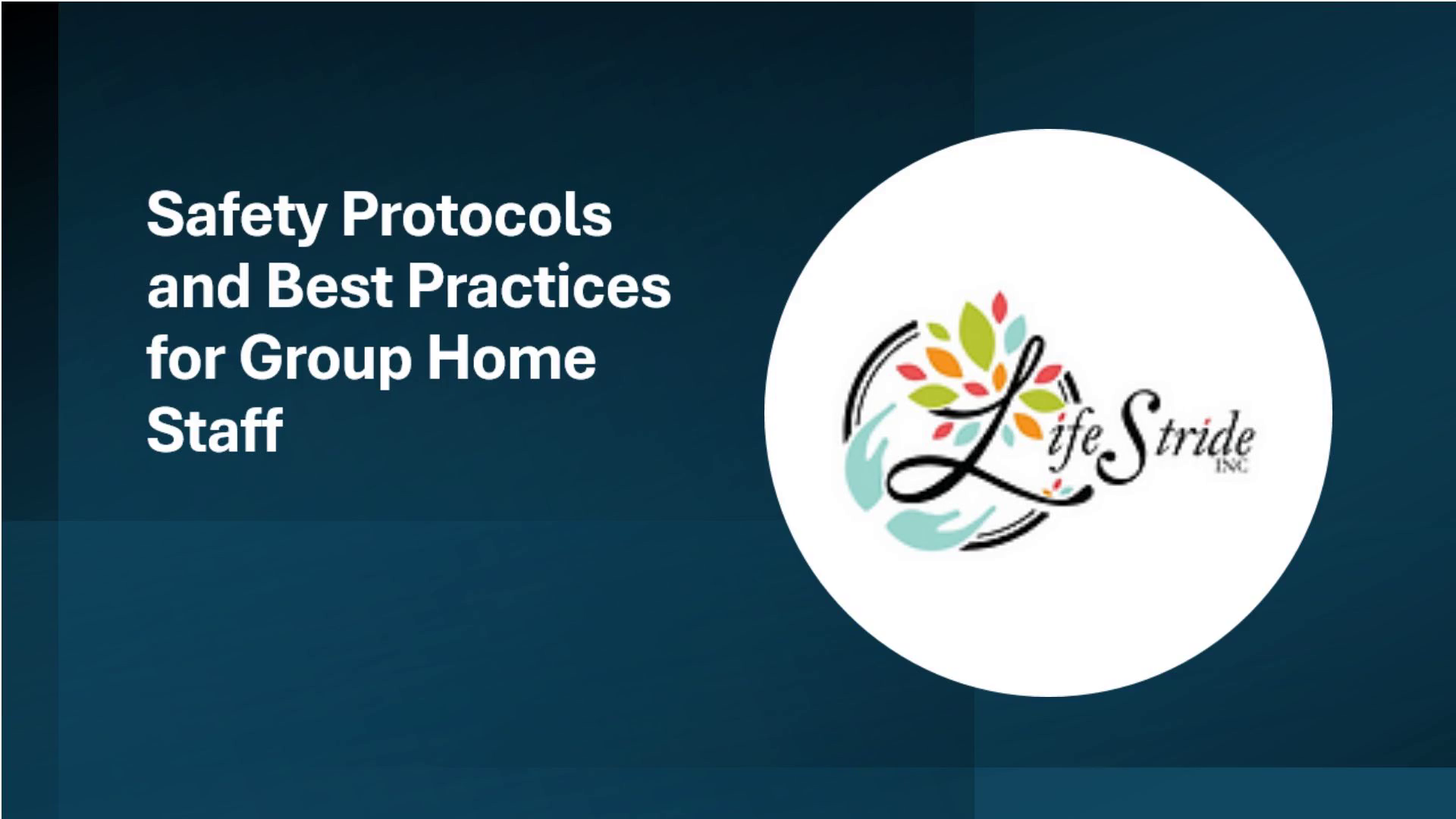
Safety Protocols and Best Practices for Group Home Staff
Scene 1 (0s)
[Audio] Welcome to our training on Safety Protocols and Best Practices for Group Home Staff. In this session, we'll explore practical strategies for creating a safe, supportive, and responsive group home environment. Your role is vital—residents depend on you not just for care, but for safety and stability. Let's learn how we can prevent harm, respond quickly to emergencies, and uphold the highest standards of support. Example Imagine walking into a group home where the fire extinguisher is blocked, the medication cabinet is left unlocked, and residents are unsupervised. This training will help ensure that never happens on your watch..
Scene 2 (41s)
[Audio] By the end of this course, you'll be equipped to recognize safety risks unique to Life Stride homes, implement protocols to reduce those risks, and handle emergencies with calm and confidence. You'll also learn the basics of medication safety, behavior management, and environmental safety practices. Example For instance, you'll learn how to spot early signs of a medical crisis, prevent choking hazards during mealtime, and properly administer and document medications..
Scene 3 (1m 15s)
[Audio] Safety in group homes starts with understanding the environment and the people in it. Challenges may include aggression, medical needs, environmental hazards, or staff fatigue. As staff, you have both a legal and ethical obligation to create a safe living space for all residents. Example Think about a resident who frequently paces and forgets to turn off the stove—understanding their safety plan can prevent house-wide emergencies..
Scene 4 (1m 43s)
[Audio] Residents with mental disabilities may face heightened safety risks like elopement, choking, or aggression. It's essential to assess each individual's needs, triggers, and abilities to tailor safety protocols appropriately. Example: One resident may be at high risk for choking and require food modifications, while another may need additional supervision during transitions to prevent elopement..
Scene 5 (2m 11s)
[Audio] Prevention is the best form of protection. Establishing predictable routines, cleaning regularly, practicing infection control, and ensuring proper food handling are vital to reducing daily risk. Example: Using a daily checklist can ensure exits are clear, hazardous items are locked away, and the home is free of tripping hazards before residents even wake up..
Scene 6 (2m 37s)
[Audio] Behavior challenges often arise from unmet needs or misunderstandings. By using de-escalation strategies—like calm tone, body language, space, and validation—we can reduce aggressive behaviors without resorting to restraint. This training is supplemented by a full Conflict Resolution Training class. Example: If a resident begins yelling due to overstimulation, removing them from the space and offering headphones may help them regain calm without confrontation..
Scene 7 (3m 9s)
[Audio] Medication errors can have life-threatening consequences. Always double-check labels, dosages, and timing. Store medications securely and document each administration accurately. Example: If a resident says, 'I already took that pill,' but there's no documentation, pause and confirm before proceeding. Communication with coworkers and pharmacies is key..
Scene 8 (3m 33s)
[Audio] Hazards in the home—like blocked exits, broken locks, or unsecured furniture—can become serious threats. Fire safety plans must be reviewed regularly, and staff should know the locations of fire extinguishers and emergency exits. Example: A loose rug near the bathroom can cause a fall. Installing rails and removing obstructions are simple but life-saving fixes..
Scene 9 (3m 59s)
[Audio] It's important to monitor what residents bring into the home when they return from community outings. While well-intentioned, residents may unknowingly collect items such as chairs, tables, or decorative trinkets from the street. These items can introduce serious health risks, including bedbugs, roaches, or other contaminants. Staff must be vigilant and take appropriate action to inspect, sanitize, or dispose of such items to maintain a clean, safe, and healthy environment. Example: For example, a resident may bring in a small side table they found on the sidewalk. While it may appear harmless, such furniture could be infested with bedbugs. Staff should kindly explain the risks and work with the resident to remove or treat the item safely..
Scene 10 (4m 49s)
[Audio] We repeat this slide to emphasize that environmental adjustments—like adding wheelchair ramps or anti-scald valves—should be tailored to resident needs. Your role is to observe, report, and act to keep spaces safe and accessible. Example: If a resident with mobility issues struggles with stairs, requesting a ramp installation isn't optional—it's essential..
Scene 11 (5m 17s)
[Audio] In a crisis, your calm response saves lives. Whether it's fire, flood, seizure, or missing resident—your job is to follow the emergency plan, contact appropriate responders, and protect those in your care. Example / Scenario: If a resident has a seizure, turn them on their side, clear the area, and time the event. Don't leave them alone, and don't try to restrain them..
Scene 12 (5m 43s)
[Audio] Safety is a team effort. When communication is strong, risks go down. Debrief after incidents, give and receive feedback, and support one another. Together, we create a culture where safety isn't just a rule—it's a shared value. Example: After a near-miss where a resident almost fell, the team meets to discuss what happened, what was done right, and how to prevent a future incident..
Scene 13 (6m 10s)
[Audio] Thank you for your attention and dedication. Your role in keeping our residents safe is critical. If you have any questions about today's material or specific protocols, please reach out directly. Example: You can also request additional training through your supervisor or speak with Mr. Yaqin Upshaw..